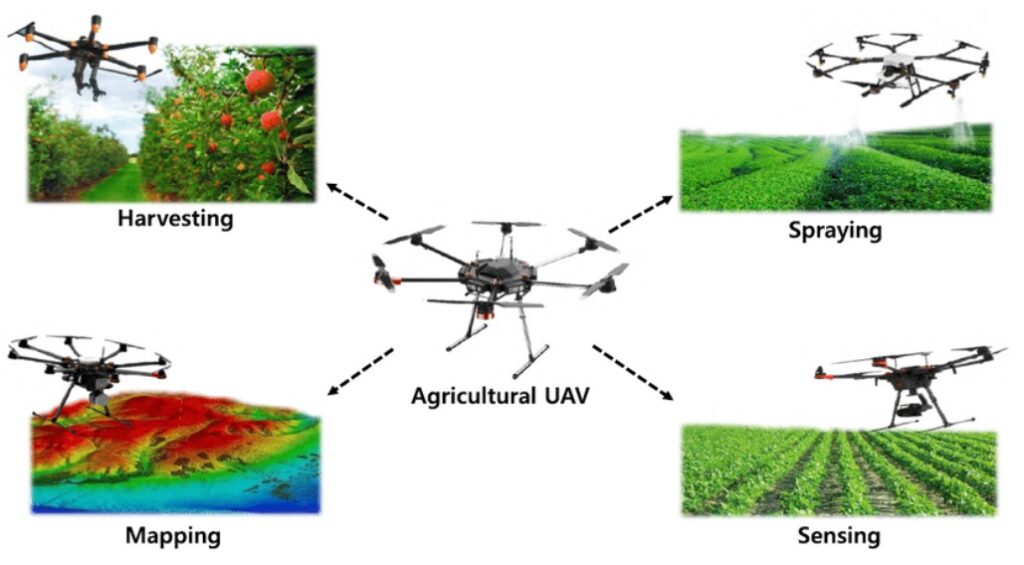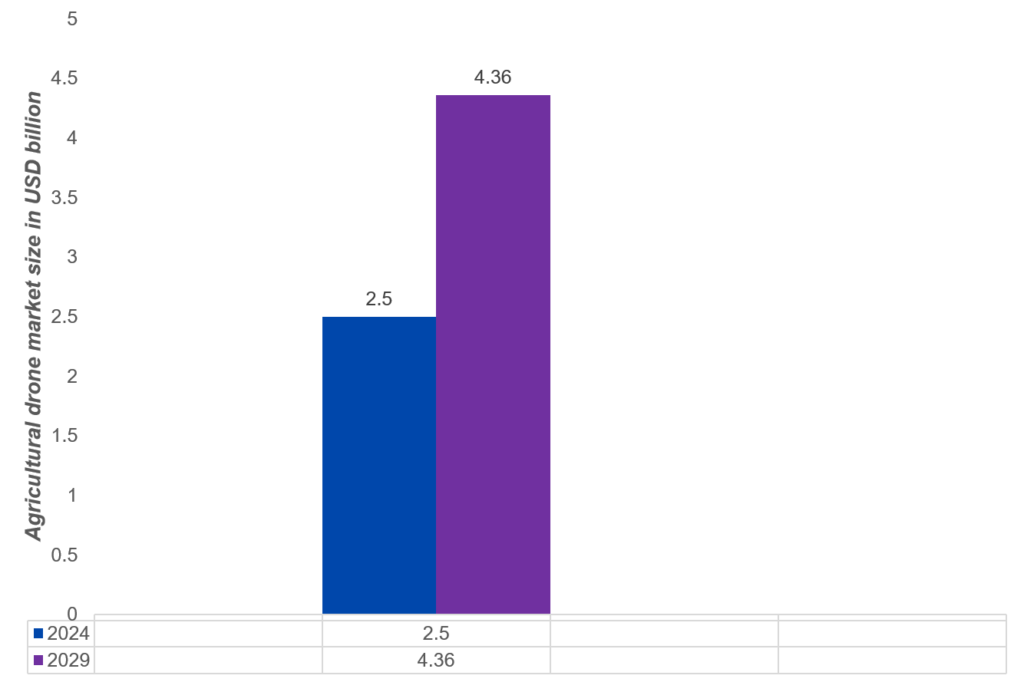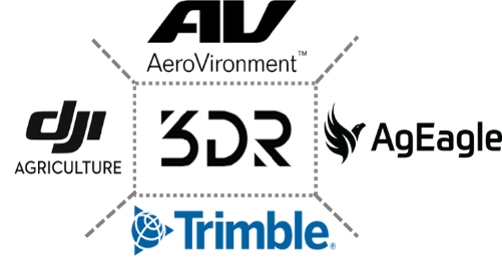Agricultural techniques have included an increasing variety of technology in an effort to boost crop output and lower operating costs to meet the growing food demands of the global population. Productivity, efficiency, and profitability are the primary concerns of every farm firm. Because of this, resource management is essential. Demand and supply have to coexist. Farmers, ranchers, and other small business owners in the agriculture industries are increasingly turning to technology like ‘agricultural drones’ for assistance as they navigate risks from crop disease, weather, supply chain interruptions, and other hazards.
Using less time and more accuracy than conventional methods, agricultural drones monitor livestock, deliver targeted pesticides or fertilizers, and evaluate soil conditions and crop health. As this incredible shift approaches, it is imperative that we examine the many uses, market trends, and developing technology surrounding drone usage in modern agriculture.
What are Agricultural Drones?
Agricultural drones, also known as “unmanned aerial vehicles (UAVs),” are utilized in livestock monitoring, precision farming, smart greenhouses, horticulture, and forestry, among other agricultural applications. They are basic, inexpensive aerial camera platforms with sensors and GPS for pertinent data collection and an autopilot.

Figure 1: Major applications of agricultural drones
Drones used for agriculture with a conventional camera can offer some insights into plant growth, coverage, etc. Thanks to multispectral sensors, farmers may now observe factors such as soil moisture content, plant health, stress levels, and developing fruits that are not visible to the human eye, further broadening their range of uses. These could aid in overcoming the different obstacles that impede agricultural productivity.
Drone technology helps preserve soil fertility, reduce the overuse of water and pesticides, and herbicides, increase productivity, and enhance crop quality. It also helps to make efficient use of human labour. Due to their ability to provide wide-ranging, higher-resolution imagery and more thorough data collection, drones in agriculture have emerged as a potent tool for crop and livestock monitoring, among many other applications.
Types of Drones in Agriculture –
Various types of drones are used in agricultural technology. Each variety possesses distinct qualities and capabilities, making it appropriate for varied tasks.
Following are some of the commonly used agricultural drones –
Fixed-Wing Drones –
- Their fixed-wing design enables them to cover more ground and stay in the air for extended periods of time
- Frequently used to map fields, monitor crops, and detect possible problems like pests or irrigation concerns
Single Rotor Drones –
- Also known as ‘helicopter drones,’ they are used in agriculture to collect high-quality data and pictures for crop analysis and mapping
- They can fly for longer periods and carry larger payloads, making them perfect for more sophisticated uses like precision farming
- Additionally, they have sophisticated sensors and cameras installed to gather information on soil quality, crop health, and other environmental aspects
Multi-Rotor Drones –
- Perfect for close-range tasks like crop monitoring and analysis since they are incredibly versatile and can fly in any direction
- Large agricultural areas are frequently mapped and surveyed by multirotor drones, which offer high-resolution aerial photography useful for identifying crop health, spotting irrigation problems, and monitoring pest and disease outbreaks
Hybrid Drones –
- They exhibit the combined benefits of fixed-wing and multirotor drones, possessing the longer range and endurance of fixed-wing drones and their vertical take-off and landing (VTOL) capabilities
- Used in agriculture for several tasks, such as pesticide spraying, crop scouting, and mapping crops, and can identify parts of the farm that could require additional fertilizer or irrigation, monitor soil moisture levels, and spot crop stress
Sensors Used in Agricultural Drones –
An array of sensors are deployed in agricultural drones, some of which are mentioned below-
- Multispectral Cameras—These sensors, which gather data at several wavelengths, allow farmers to monitor plant health, identify early disease symptoms, and detect nutrient deficits.
- RGB Cameras—These sensors capture High-resolution photos of crops, giving farmers comprehensive information on crop health, growth rates, and problems like pest infestations.
- Multispectral Cameras—These sensors allow farmers to monitor plant health, identify early disease symptoms, and detect nutrient deficits. They gather data at several wavelengths.
- Thermal Cameras – These sensors detect heat signatures, giving farmers important data about pest infestations, plant stress, and irrigation requirements.
- LiDAR – These sensors allow farmers to examine topographical data, recognize crop patterns, and plan for more effective planting by using lasers to produce 3D maps of the terrain.
- GPS—This sensor allows drones to map fields autonomously, track crop development, and spot possible problems.
Applications of Drones in Agriculture –
- Soil and Field Analysis—Drones can be quite helpful early in the crop cycle. They generate accurate three-dimensional maps for early soil investigation, which can be used to design seed planting patterns. Drone-based soil analysis also gives information for managing nitrogen levels and irrigation after planting.
- Planting—Start-up drone-planting solutions have an uptake rate of 75% and save 85% on planting expenses. By launching plant-nutrient-filled pods into the soil, these systems give plants all the resources they need to survive.
- Crop Spraying – Drones equipped with distance-measuring devices, such as ultrasonic echoes and lasers used in the light-detection and ranging, or LiDAR method, can modify their altitude in response to changes in topography and geography, preventing collisions. Drones are able to adjust their distance from the ground and spray in real time for uniform coverage, all while scanning the ground and sprinkling the appropriate amount of liquid. By applying pesticides and fertilizers more precisely than with conventional methods, drones can help reduce the amount of chemicals used and their negative effects on the environment.
- Crop Monitoring – Drones can be used by farmers to monitor their crops from above, collecting information on crop health, pest and disease activity, and irrigation needs. This information can be used to make informed decisions about crop management, such as when to apply fertilizer or insecticides.
- Irrigation – Drones equipped with thermal, multispectral, or hyperspectral sensors may determine which areas of a field want improvement or are dry. Drones also make it possible to calculate the vegetation index, which indicates the crop’s relative density and health, and display the crop’s heat signature, which indicates how much heat or energy it emits once it has begun to grow.
- Mapping and Imaging Purposes – At every stage of the manufacturing process, drone platforms’ mapping and imaging capabilities with a range of sensors may be used to improve production planning and efficiency. To estimate potential yields, drone technology can be utilized to assess the condition of the soil before the onset of the growing cycle. By far, the most significant application for assessing soil condition is actual 3D mapping of the terrain with precise coverage of soil color. This helps determine soil quality and moisture and water movement in the soil more precisely. Throughout the vegetative phase, planners can employ cyclic flights to monitor crops and the agricultural process, enabling them to schedule operations and move fast to address issues as they emerge.
- Health Assessment—Evaluating crop health and identifying fungal or bacterial infections in trees is critical. Drone-carried equipment can detect which plants reflect various quantities of green light and near-infrared light by scanning a crop using both visible and NIR light. This information can be used to create multispectral photographs that track changes in plants and show their health. Additionally, farmers may more accurately apply and monitor medicines as soon as a disease is identified.
- Weed Control—Drones can precisely identify and target weeds using high-resolution sensors and cutting-edge AI technology, eliminating the need for blanket herbicide applications. This focused strategy reduces the amount of herbicide used, saves farmers money, and boosts yields overall. Herbicides can be sprayed directly on the targeted weeds using drones fitted with sprayers. This minimizes drift and lowers the possibility of herbicide damage to nearby crops.
Market Trends

Figure 2: Agricultural drone market size in USD billion during the forecast period (2024-2029)
The market for agricultural drones is projected to be worth USD 2.08 billion in 2024 and expand at a compound annual growth rate (CAGR) of 16.05% to reach USD 4.36 billion by 2029.
With more business activity, research, and investment, North America is one of the largest markets, with the United States ranking among the most significant. The market for agricultural drone technology is expanding at one of the quickest rates in Europe.
Key Market Players –

Figure 3: Key market players in the agricultural drone market
- DJI Agriculture – A private company established in 2015 in China, provides an extensive range of crop protection drones, such as the Phantom 4 RTK, P4 Multispectral, MG-1, MG-1S, and T16. Additionally, DJI has released the DJI Agriculture Data Management Platform, a specialized program.
- AgEagle – A public company founded in 2010 with its base in the United States, provides drones, sensors, and software services for pest and disease identification, population counts, and crop health monitoring in precision agriculture.
- AeroVironment Inc. – A public company headquartered in the United States since 1971 provides farmers with precision solutions that help them monitor field conditions, maximize yields, and optimize crop health.
- 3DR – A private company established in 2009 in the United States, develops and produces vital electronic components for unmanned aerial vehicles, or Unmanned Aerial Vehicles (UAVs). It was acquired by Kitty Hawk in June 2021.
- Trimble – A public company with its base in the United States since 1978, offers hardware and software services that help the agricultural sector by cutting down on the amount of time operators spend on machinery and enhancing safety by using technology to optimize farm operations.
Future Trends and Advancements in Drone Technology –
- Advanced AI and Machine Learning – Drones are entering the sphere of smart agriculture thanks to the integration of automation, machine learning, and artificial intelligence in agriculture. Drones equipped with AI-powered software will offer farmers comprehensive insights as data analytics progress, from forecasting yield patterns to suggesting the optimal planting times. The smart agricultural ecosystem will encourage a proactive approach to farming with data-driven decision-making, resource optimization, and an emphasis on sustainability.
- Drone Swarming—Novel uses, including swarming drones carrying out coordinated activities, are promised for the future. Drone swarms can rapidly cover large regions, carrying out functions including pollination, cooperative planting, and agricultural monitoring. This cooperative approach accelerates the adoption of new farming techniques and increases efficiency.
- Integration with Other Technologies—Drones for agricultural purposes can be combined with other cutting-edge technologies like blockchain, Internet of Things (IoT) gadgets, and satellite photography. This integration will help farmers thoroughly understand their activities and build a robust ecosystem.
- Increased Integration of Multispectral Sensors – Agriculture drones increasingly utilize multispectral sensors. These sensors record information in a range of spectrums, including infrared, which enables a more thorough and precise examination of crops. Farmers may evaluate the health of their plants, find diseases, and apply nutrients as efficiently as possible by using multispectral imaging.
- Customization for Specialized Agriculture – The demands of farmers vary based on the sorts of crops they grow and the unique obstacles they face. In response, manufacturers are providing drones that can be customized to meet various farming needs. Specialized drones are made to meet the specific needs of different agricultural environments, be it vineyards, orchards, or large fields of crops.
- Enhance Data-Analytics Services – It involves more than just gathering data—it involves deriving useful ideas. More and more drone companies for agriculture are providing data analytics services. These programs assist farmers in understanding drone data and translating it into useful suggestions for maximizing crop management.
- Drone-as-a-Service (DaaS) Models—With the rising popularity of drone-as-a-service (DaaS) models, farmers may now use drone technology without paying the initial expense of buying and maintaining their own drones. DaaS providers enable a wider range of farmers to access drone technology by providing drone services for particular chores.
Conclusion
The industry for drones used in agriculture is expanding and innovating at an astonishing rate. Drones are becoming more than just tools; they are intelligent, self-governing collaborators in modern agricultural operations. Drone applications in agriculture are also expected to grow, transforming the farming environment with applications ranging from soil and field analysis to weed control. Future developments could include enhanced automation, extended battery life, and artificial intelligence integration for immediate decision-making. These advancements will solidify drones’ position as an essential component of modern farming.